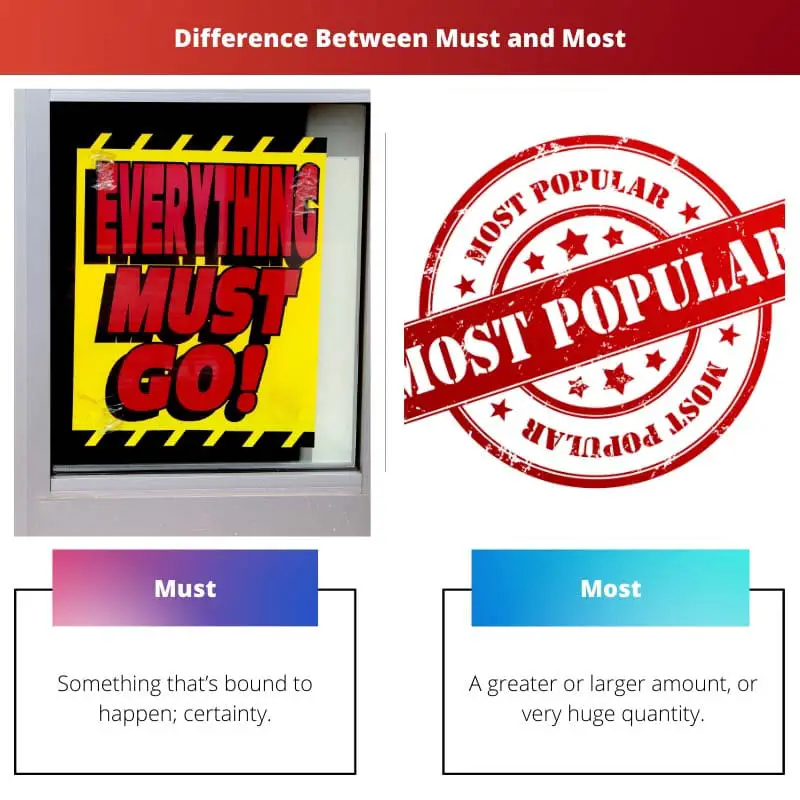Many words in English are encountered. From prepositions to conjunctions, there’s a lot to learn. It’s common to be perplexed by words that are identical or sound the same. To make your speech meaningful and precise, you must distinguish.
Some terms can be used interchangeably because they are slightly different, and experts can determine the distinction, but when people hear them regularly, they sound identical.
Auxiliary verbs, also known as supporting verbs, are used in conjunction with the main verb to convey the mood, tense, and voice of the main verb.
Key Takeaways
- “Must” is a modal verb to express a strong obligation or necessity, whereas “most” is an adjective used to indicate the greatest amount or quantity.
- “Must” imply a mandatory requirement or imperative action, while “most” indicate a comparative degree of quantity or quality.
- “Must” is commonly used in formal or legal language, while “most” is used in formal and informal contexts to describe an excellent degree of something.
Must vs Most
The difference between must and most is that must is a word that confirms certainty, whereas most is a word that quantifies something. While most are used in situations or cases of urgency or confidence, most are used in cases of comparisons or quantification of something. Both of them are used in addition to a predicate or a verb.

Must is used to ensure something or to say something which is about to happen or something sure to happen. The speaker here is confident that the subject would have followed the predicate. For example, The sun has been up for a while; it must be hot outside.
The boys must have finished their homework by dinner time.
Most can be used to describe a large amount or to show the majority in something. For example, Most people like flowers. Most school children find it challenging to study on computer screens. At this hour, most of the customers make their reservations.
Most of the earth’s surface is covered with water bodies.
Comparison Table
| Parameters of Comparison | Must | Most |
|---|---|---|
| Meaning | Something that’s bound to happen; certainty | A greater or larger amount or huge quantity |
| Synonyms | Necessary, requisite, commitment, requirement, right, a precondition | Better, greater, higher, larger, uttermost, maximum, highly, immensely |
| Antonyms | Nonessential, non-necessity | At least, little, negligible, somewhat, slightly |
| Represents | Obligations | Quantifications |
| Used as | Verb, noun | Determiner, adverb, pronoun, noun |
What is Must?
Must is something that is necessary or mandatory and is bound to happen. Must is used to say something that one needs to do or something significant. For example, You must complete all the college application forms for the economics department.
It must address urgency or something significant and may result in negative consequences if not done as required. You must report to the examination hall before 9 am, or you won’t be allowed to take the exam.
“Arise, and go into the city, and it shall be told thee what thou must do (Bible, Acts 9:6)”.
Must describe an event that is very likely or has a high chance of happening. For example, The chefs must have prepared the dinner by now. It is also used to describe something that is mandatory or is required to happen.
For example, I am going hiking, so first aid is necessary.

What are Most?
Most is a verb that describes a large amount or quantity or represents the majority concerning a population. It has a quantitative nature and describes things quantitatively. For example, Most of the fruits at the market are fresh today.
Most can be used in comparisons of a more significant number. The team to collect most of the flags wins the game. Most can also be used in the case to show the majority or to represent more than half. For example, Most dairy products are frozen and sold in a chilled state.
Most can also be used as an excellent form of many adjectives. For example, Calibration is the most important while using any instrument in the lab. Most can also be used to represent a more significant part, as in the case of a large group of people.
For example, Most people are using the postpaid communication system. Most have been used to describe a record-setting amount. Asha Bhosle held the Guinness world record for the most-recorded artist in music history in 2011.

Main Differences Between Must and Most
- The main difference between must and most is the first is used in a situation or cases of certainty or when something is about to happen, while the latter is used in points of comparison to show an amount, as in quantifying something.
- Must is used in cases to show necessity or when one is obligated to do something, while most can represent a more significant or larger portion of people or things.
- It must be used in expressing formal speech. Most can also represent facts, data, or any statements. It can be used formally and informally depending on the situation’s demand.
- It must represent the importance of anything, any critical work, or any law or rule to be followed. Most represent a more comprehensive range of a broader portion of a group.
- Must is used to express any obligation, to show prohibition, or to express strong opinions and actions to be taken. Most can be used in comparisons or when talking about majority cases.

- https://link.springer.com/article/10.1007%2FBF00353453
- https://books.google.co.in/books?hl=en&lr=&id=aEXUDAAAQBAJ&oi=fnd&pg=PT9&ots=HpkwXCTfN4&sig=wHo6KbbmL-sUtSXSiNagpPdIt70&redir_esc=y#v=onepage&q&f=false

I think the article could use more humor to make the explanations more engaging and enjoyable to read.
This article provides a comprehensive understanding of the differences between ‘must’ and ‘most’. It’s a great resource for anyone learning English.
I think it’s useful to have detailed explanations like this. It can help to clear up any confusion or doubts.
This is basic knowledge that most people already know. It’s not necessary to explain it in such detail.
The article has cleared up any confusion I had about when to use ‘must’ and ‘most’. It’s written in a very accessible manner.
I think the language used in the article is too complex. It could be simplified for easier understanding.
The level of writing is perfect for explaining these concepts. It’s accessible yet intellectual.
I appreciated the clear definitions provided for ‘must’ and ‘most’, and the article is well-structured.
I think the structure is perfect for presenting the necessary information clearly. I like the organization.
The structure of the article is a bit too rigid for my liking. It lacks flow and creativity.
This article provides excellent examples of how to use ‘must’ and ‘most’ in sentences. The distinctions are much clearer now.
I found the examples to be really useful and easy to understand. Great job!
I think the examples were too basic and could be more varied and challenging.
The comparison table is a great visual aid to see the differences between ‘must’ and ‘most’. It really helps to reinforce the explanations.
I think the table is more confusing than helpful. The article is informative, but the table could be simplified.
I think that the comparison table makes the differences clearer. It’s a useful resource alongside the explanations.
The examples provided throughout the article are very comprehensive and greatly aid in understanding the differences between ‘must’ and ‘most’.
The examples were too simplistic and could be improved to cover a wider range of meanings.
I found the examples to be quite varied and helpful in illustrating the distinctions between ‘must’ and ‘most’.
This article has been incredibly helpful in explaining the difference between ‘must’ and ‘most’. The examples are clear and really help to understand the context in which each word should be used.
I agree! The definitions and examples provided are very clear and informative.
I don’t think so. I find the explanations too simplistic, and the writing is a bit patronizing. This article could be improved.
This article was very informative and has greatly improved my understanding of the proper usage of ‘must’ and ‘most’.
The section on ‘Comparison Table’ provides a great summary of the key differences between ‘must’ and ‘most’. It’s very helpful for quick reference.
I don’t think the comparison table adds much value. The explanations are good enough on their own.
I agree, the comparison table is an excellent addition to the article.